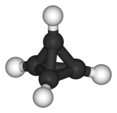Alkane

In
(C14H30).The International Union of Pure and Applied Chemistry (IUPAC) defines alkanes as "acyclic branched or unbranched hydrocarbons having the general formula CnH2n+2, and therefore consisting entirely of hydrogen atoms and saturated carbon atoms". However, some sources use the term to denote any saturated hydrocarbon, including those that are either monocyclic (i.e. the cycloalkanes) or polycyclic, despite their having a distinct general formula (i.e. cycloalkanes are CnH2n).
In an alkane, each carbon atom is sp3-hybridized with 4 sigma bonds (either C–C or C–H), and each hydrogen atom is joined to one of the carbon atoms (in a C–H bond). The longest series of linked carbon atoms in a molecule is known as its carbon skeleton or carbon backbone. The number of carbon atoms may be considered as the size of the alkane.
One group of the
Methane is produced by methanogenic bacteria and some long-chain alkanes function as pheromones in certain animal species or as protective waxes in plants and fungi. Nevertheless, most alkanes do not have much biological activity. They can be viewed as molecular trees upon which can be hung the more active/reactive functional groups of biological molecules.
The alkanes have two main commercial sources: petroleum (crude oil) and natural gas.
An
Structure and classification
Ordinarily the C-C single bond distance is 1.53
Isomerism
Alkanes with more than three carbon atoms can be arranged in various ways, forming structural isomers. The simplest isomer of an alkane is the one in which the carbon atoms are arranged in a single chain with no branches. This isomer is sometimes called the n-isomer (n for "normal", although it is not necessarily the most common). However, the chain of carbon atoms may also be branched at one or more points. The number of possible isomers increases rapidly with the number of carbon atoms. For example, for acyclic alkanes:[3]
- C1: methane only
- C2: ethane only
- C3: propane only
- C4: 2 isomers: butane and isobutane
- C5: 3 isomers: pentane, isopentane, and neopentane
- C6: 5 isomers: hexane, 2-methylpentane, 3-methylpentane, 2,2-dimethylbutane, and 2,3-dimethylbutane
- C7: 9 isomers: 2,2,3-trimethylbutane
- C8: 18 isomers: 2,2,3,3-tetramethylbutane
- C9: 35 isomers
- C10: 75 isomers
- C12: 355 isomers
- C32: 27,711,253,769 isomers
- C60: 22,158,734,535,770,411,074,184 isomers, many of which are not stable
Branched alkanes can be
Branched alkanes are more thermodynamically stable than their linear (or less branched) isomers. For example, the highly branched 2,2,3,3-tetramethylbutane is about 1.9 kcal/mol more stable than its linear isomer, n-octane.[4]
Nomenclature
The IUPAC nomenclature (systematic way of naming compounds) for alkanes is based on identifying hydrocarbon chains. Unbranched, saturated hydrocarbon chains are named systematically with a Greek numerical prefix denoting the number of carbons and the suffix "-ane".[5]
In 1866,
Linear alkanes
Straight-chain alkanes are sometimes indicated by the prefix "n-" or "n-"(for "normal") where a non-linear isomer exists. Although this is not strictly necessary and is not part of the IUPAC naming system, the usage is still common in cases where one wishes to emphasize or distinguish between the straight-chain and branched-chain isomers, e.g., "n-butane" rather than simply "butane" to differentiate it from isobutane. Alternative names for this group used in the petroleum industry are linear paraffins or n-paraffins.
The first eight members of the series (in terms of number of carbon atoms) are named as follows:
- methane
- CH4 – one carbon and 4 hydrogen
- ethane
- C2H6 – two carbon and 6 hydrogen
- propane
- C3H8 – three carbon and 8 hydrogen
- butane
- C4H10 – four carbon and 10 hydrogen
- pentane
- C5H12 – five carbon and 12 hydrogen
- hexane
- C6H14 – six carbon and 14 hydrogen
- heptane
- C7H16 – seven carbons and 16 hydrogen
- octane
- C8H18 – eight carbons and 18 hydrogen
The first four names were
Branched alkanes
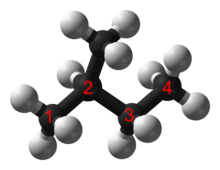
Simple branched alkanes often have a common name using a prefix to distinguish them from linear alkanes, for example n-pentane, isopentane, and neopentane.
IUPAC naming conventions can be used to produce a systematic name.
The key steps in the naming of more complicated branched alkanes are as follows:[9]
- Identify the longest continuous chain of carbon atoms
- Name this longest root chain using standard naming rules
- Name each side chain by changing the suffix of the name of the alkane from "-ane" to "-yl"
- Number the longest continuous chain in order to give the lowest possible numbers for the side-chains[10]
- Number and name the side chains before the name of the root chain
- If there are multiple side chains of the same type, use prefixes such as "di-" and "tri-" to indicate it as such, and number each one.
- Add side chain names in alphabetical (disregarding "di-" etc. prefixes) order in front of the name of the root chain
| Common name | n-pentane | isopentane | neopentane |
|---|---|---|---|
| IUPAC name | pentane | 2-methylbutane | 2,2-dimethylpropane |
| Structure |  |

|
Saturated cyclic hydrocarbons
Though technically distinct from the alkanes, this class of hydrocarbons is referred to by some as the "cyclic alkanes." As their description implies, they contain one or more rings.
Simple cycloalkanes have a prefix "cyclo-" to distinguish them from alkanes. Cycloalkanes are named as per their acyclic counterparts with respect to the number of carbon atoms in their backbones, e.g., cyclopentane (C5H10) is a cycloalkane with 5 carbon atoms just like pentane (C5H12), but they are joined up in a five-membered ring. In a similar manner, propane and cyclopropane, butane and cyclobutane, etc.
Substituted cycloalkanes are named similarly to substituted alkanes – the cycloalkane ring is stated, and the substituents are according to their position on the ring, with the numbering decided by the Cahn–Ingold–Prelog priority rules.[8]
Trivial/common names
The trivial (non-
Branched-chain alkanes are called isoparaffins. "Paraffin" is a general term and often does not distinguish between pure compounds and mixtures of isomers, i.e., compounds of the same chemical formula, e.g., pentane and isopentane.
- In IUPAC
The following trivial names are retained in the IUPAC system:
- isobutane for 2-methylpropane
- isopentane for 2-methylbutane
- neopentane for 2,2-dimethylpropane.
- Non-IUPAC
Some non-IUPAC trivial names are occasionally used:
- cetane, for hexadecane
- cerane, for hexacosane[13]
Physical properties
All alkanes are colorless.[14][15] Alkanes with the lowest molecular weights are gases, those of intermediate molecular weight are liquids, and the heaviest are waxy solids.[16][17]
Table of alkanes
| Alkane | Formula | Boiling point[note 1] [°C] |
Melting point[note 1] [°C] |
Density[note 1] [kg/m3] (at 20 °C) |
Isomers[note 2] |
|---|---|---|---|---|---|
| Methane | CH4 | −162 | −182 | 0.656 (gas) | 1 |
| Ethane | C2H6 | −89 | −183 | 1.26 (gas) | 1 |
| Propane | C3H8 | −42 | −188 | 2.01 (gas) | 1 |
| Butane | C4H10 | 0 | −138 | 2.48 (gas) | 2 |
| Pentane | C5H12 | 36 | −130 | 626 (liquid) | 3 |
| Hexane | C6H14 | 69 | −95 | 659 (liquid) | 5 |
| Heptane | C7H16 | 98 | −91 | 684 (liquid) | 9 |
| Octane | C8H18 | 126 | −57 | 703 (liquid) | 18 |
| Nonane | C9H20 | 151 | −54 | 718 (liquid) | 35 |
| Decane | C10H22 | 174 | −30 | 730 (liquid) | 75 |
| Undecane | C11H24 | 196 | −26 | 740 (liquid) | 159 |
| Dodecane | C12H26 | 216 | −10 | 749 (liquid) | 355 |
| Tridecane | C13H28 | 235 | −5.4 | 756 (liquid) | 802 |
| Tetradecane | C14H30 | 253 | 5.9 | 763 (liquid) | 1858 |
| Pentadecane | C15H32 | 270 | 10 | 769 (liquid) | 4347 |
| Hexadecane | C16H34 | 287 | 18 | 773 (liquid) | 10,359 |
| Heptadecane | C17H36 | 303 | 22 | 777 (solid) | 24,894 |
| Octadecane | C18H38 | 317 | 28 | 781 (solid) | 60,523 |
| Nonadecane | C19H40 | 330 | 32 | 785 (solid) | 148,284 |
| Icosane | C20H42 | 343 | 37 | 789 (solid) | 366,319 |
Triacontane
|
C30H62 | 450 | 66 | 810 (solid) | 4,111,846,763 |
Tetracontane
|
C40H82 | 525 | 82 | 817 (solid) | 62,481,801,147,341 |
Pentacontane
|
C50H102 | 575 | 91 | 824 (solid) | 1,117,743,651,746,953,270 |
Hexacontane
|
C60H122 | 625 | 100 | 829 (solid) | 2.21587345357704×1022 |
| Heptacontane | C70H142 | 653 | 109 | 869 (solid) | 4.71484798515330×1026 |
Boiling point

Alkanes experience intermolecular van der Waals forces. The cumulative effects of these intermolecular forces give rise to greater boiling points of alkanes.[18]
Two factors influence the strength of the van der Waals forces:
- the number of electrons surrounding the molecule, which increases with the alkane's molecular weight
- the surface area of the molecule
Under
A straight-chain alkane will have a boiling point higher than a branched-chain alkane due to the greater surface area in contact, and thus greater van der Waals forces, between adjacent molecules. For example, compare
On the other hand, cycloalkanes tend to have higher boiling points than their linear counterparts due to the locked conformations of the molecules, which give a plane of intermolecular contact.
Melting points
The
The melting points of branched-chain alkanes can be either higher or lower than those of the corresponding straight-chain alkanes, again depending on the ability of the alkane in question to pack well in the solid phase.
Conductivity and solubility
Alkanes do not conduct electricity in any way, nor are they substantially
Their solubility in nonpolar solvents is relatively high, a property that is called lipophilicity. Alkanes are, for example, miscible in all proportions among themselves.
The density of the alkanes usually increases with the number of carbon atoms but remains less than that of water. Hence, alkanes form the upper layer in an alkane–water mixture.[21]
Molecular geometry
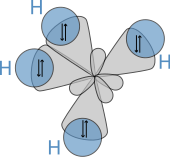
The molecular structure of the alkanes directly affects their physical and chemical characteristics. It is derived from the electron configuration of carbon, which has four valence electrons. The carbon atoms in alkanes are described as sp3 hybrids; that is to say that, to a good approximation, the valence electrons are in orbitals directed towards the corners of a tetrahedron which are derived from the combination of the 2s orbital and the three 2p orbitals. Geometrically, the angle between the bonds are cos−1(−1/3) ≈ 109.47°. This is exact for the case of methane, while larger alkanes containing a combination of C–H and C–C bonds generally have bonds that are within several degrees of this idealized value.
Bond lengths and bond angles

An alkane has only C–H and C–C single bonds. The former result from the overlap of an sp3 orbital of carbon with the 1s orbital of a hydrogen; the latter by the overlap of two sp3 orbitals on adjacent carbon atoms. The bond lengths amount to 1.09 × 10−10 m for a C–H bond and 1.54 × 10−10 m for a C–C bond.
The spatial arrangement of the bonds is similar to that of the four sp3 orbitals—they are tetrahedrally arranged, with an angle of 109.47° between them. Structural formulae that represent the bonds as being at right angles to one another, while both common and useful, do not accurately depict the geometry.
Conformation
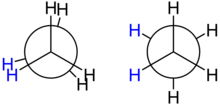
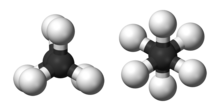
The spatial arrangement of the C-C and C-H bonds are described by the torsion angles of the molecule is known as its
Spectroscopic properties
Spectroscopic signatures for alkanes are obtainable by the major characterization techniques.[23]
Infrared spectroscopy
The C-H stretching mode gives a strong absorptions between 2850 and 2960 cm−1 and weaker bands for the C-C stretching mode absorbs between 800 and 1300 cm−1. The carbon–hydrogen bending modes depend on the nature of the group: methyl groups show bands at 1450 cm−1 and 1375 cm−1, while methylene groups show bands at 1465 cm−1 and 1450 cm−1.[24] Carbon chains with more than four carbon atoms show a weak absorption at around 725 cm−1.
NMR spectroscopy
The proton resonances of alkanes are usually found at
Mass spectrometry
Since alkanes have high
Chemical properties
Alkanes are only weakly reactive with most chemical compounds. They only reacts with the strongest of electrophilic reagents by virtue of their strong C–H bonds (~100 kcal/mol) and C–C bonds (~90 kcal/mol). They are also relatively unreactive toward free radicals. This inertness is the source of the term paraffins (with the meaning here of "lacking affinity"). In
Acid-base behavior
The
Reactions with oxygen (combustion reaction)
All alkanes react with oxygen in a combustion reaction, although they become increasingly difficult to ignite as the number of carbon atoms increases. The general equation for complete combustion is:
- CnH2n+2 + (3/2n + 1/2) O2 → (n + 1) H2O + n CO2
- or CnH2n+2 + (3n + 1/2) O2 → (n + 1) H2O + n CO2
In the absence of sufficient oxygen, carbon monoxide or even soot can be formed, as shown below:
For example, methane:
- 2 CH4 + 3 O2 → 4 H2O + 2 CO
- CH4 + O2 → 2 H2O + C
See the
Biodegradation
Some organisms are capable of metalbolizing alkanes.[27][28] The methane monooxygenases convert methane to methanol. For higher alkanes, cytochrome P450 convert alkanes to alcohols, which are then susceptible to degradation.
Free radical reactions
- Initiation the halogen radicals form by homolysis. Usually, energy in the form of heat or light is required.
- Chain reaction or Propagation then takes place—the halogen radical abstracts a hydrogen from the alkane to give an alkyl radical. This reacts further.
- Chain termination where the radicals recombine.
Experiments have shown that all halogenation produces a mixture of all possible isomers, indicating that all hydrogen atoms are susceptible to reaction. The mixture produced, however, is not statistical: Secondary and tertiary hydrogen atoms are preferentially replaced due to the greater stability of secondary and tertiary free-radicals. An example can be seen in the monobromination of propane:[18]

In the Reed reaction, sulfur dioxide and chlorineconvert hydrocarbons to sulfonyl chlorides under the influence of light.
Under some conditions, alkanes will undergo Nitration.
C-H activation
Certain transition metal complexes promote non-radical reactions with alkanes, resulting in so
Cracking
Cracking breaks larger molecules into smaller ones. This reaction requires heat and catalysts. The thermal cracking process follows a
Isomerization and reformation
Dragan and his colleague were the first to report about isomerization in alkanes.
Other reactions
In
Occurrence
Occurrence of alkanes in the Universe
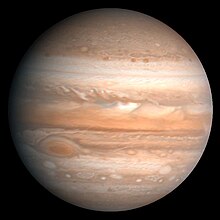
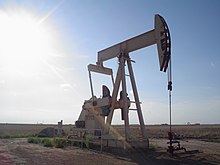
Alkanes form a small portion of the
Occurrence of alkanes on Earth
Traces of methane gas (about 0.0002% or 1745 ppb) occur in the Earth's atmosphere, produced primarily by methanogenic microorganisms, such as Archaea in the gut of ruminants.[34]
The most important commercial sources for alkanes are natural gas and
- C6H12O6 → 3 CH4 + 3 CO2
These hydrocarbon deposits, collected in porous rocks trapped beneath impermeable cap rocks, comprise commercial
Alkanes have a low solubility in water, so the content in the oceans is negligible; however, at high pressures and low temperatures (such as at the bottom of the oceans), methane can co-crystallize with water to form a solid methane clathrate (methane hydrate). Although this cannot be commercially exploited at the present time, the amount of combustible energy of the known methane clathrate fields exceeds the energy content of all the natural gas and oil deposits put together. Methane extracted from methane clathrate is, therefore, a candidate for future fuels.
Biological occurrence

Aside from petroleum and natural gas, alkanes occur significantly in nature only as methane, which is produced by some archaea by the process of methanogenesis. These organisms are found in the gut of termites[35] and cows.[36] The methane is produced from carbon dioxide or other organic compounds. Energy is released by the oxidation of hydrogen:
- CO2 + 4 H2 → CH4 + 2 H2O
It is probable that our current deposits of natural gas were formed in a similar way.[37]
RCH2\sCH3}} (R =alkyl)
Another route to alkanes is
- R3N + 3 H2 → 3 RH + H3N
- R2S + 2 H2 → 2 RH + H2S
Hydrogenolysis can be applied to the conversion of virtually any functional group into hydrocarbons. Substrates include haloalkanes, alcohols, aldehydes, ketones, carboxylic acids, etc. Both hydrogenolysis and hydrogenation are practiced in refineries. The can be effected by using
Coal
Coal is a more traditional precursor to alkanes. A wide range of technologies have been intensively practiced for centuries.
Laboratory preparation
Rarely is there any interest in the synthesis of alkanes, since they are usually commercially available and less valued than virtually any precursor. The best-known method is
Applications
Fuels
The dominant use of alkanes is as fuels.
Precursors to chemicals
By the process of cracking, alkanes can be converted to alkenes. Simple alkenes are precursors to polymers, such as polyethylene and polypropylene. When the cracking is taken to extremes, alkanes can be converted to carbon black, which is a significant tire component.
Chlorination of methane gives chloromethanes, which are used as solvents and building blocks for complex compounds. Similarly treatment of methane with sulfur gives carbon disulfide. Still other chemicals are prepared by reaction with sulfur trioxide and nitric oxide
Other
Some light hydrocarbons are used as
Alkanes from hexadecane upwards form the most important components of
Alkanes with a chain length of approximately 35 or more carbon atoms are found in bitumen, used, for example, in road surfacing. However, the higher alkanes have little value and are usually split into lower alkanes by cracking.
Hazards
Alkanes are highly flammable, but they have low toxicities. Methane "is toxicologically virtually inert." Alkanes can be asphyxiants and narcotic.[38]
See also
- Alkene
- Alkyne
- Cycloalkane
- Higher alkanes
- Aliphatic compound
References
- ^
- ISBN 978-0-471-72091-1.
- ^ On-Line Encyclopedia of Integer Sequences (sequence A000602 in the OEIS) Number of n-node unrooted quartic trees; number of n-carbon alkanes C(n)H(2n+2) ignoring stereoisomers
- OCLC 957525299.
- ISBN 978-0-632-03488-8. Retrieved 12 February 2007.
- ^ Alkane Nomenclature Archived 2 February 2012 at the Wayback Machine
- ^ Thus, the ending "-diene" is applied in some cases where von Hofmann had "-ine"
- ^ a b Reusch, William. "Nomenclature – Alkanes". Virtual Textbook of Organic Chemistry. Archived from the original on 21 May 2016. Retrieved 5 April 2007.
- ^ Reusch, William. "Examples of the IUPAC Rules in Practice". Virtual Textbook of Organic Chemistry. Archived from the original on 21 May 2016. Retrieved 5 April 2007.
- ^ "IUPAC Rules". www.chem.uiuc.edu. Retrieved 13 August 2018.
- ^ "Definition of CYCLOALKANES". www.merriam-webster.com. Retrieved 26 June 2021.
- ^ "Definition of NAPHTHENES". www.merriam-webster.com. Retrieved 26 June 2021.
- ISBN 1-4200-4439-7.
- ^ "Pharmaceutical Chemistry" (PDF). Archived from the original (PDF) on 29 October 2013. Retrieved 17 February 2014.
- ^ "13. Hydrocarbons | Textbooks". textbook.s-anand.net. Archived from the original on 8 May 2011. Retrieved 3 October 2014.
- ^ "Molecule Gallery - Alkanes". www.angelo.edu. Retrieved 6 December 2021.
- ^ Allaby, Michael, ed. (1988). "Alkanes (paraffins)". Illustrated Dictionary of Science, Andromeda. Windmill Books (Andromeda International).
- ^ ISBN 978-0-13-643669-0.
- .
- ^ "Solid methane". Visualization of Molecules and Crystal Structures.
- ISBN 978-0-12-802444-7.
- ISBN 978-0-471-72091-1
- ISBN 978-0-470-61637-6.
- ^ "Dodecane: IR Spectrum". NIST Chemistry WebBook. SRD 69.
- ^ "Dodecane". NIST Chemistry WebBook. SRD 69.
- .
- PMID 23519435.
- PMID 25740314.
- ISBN 978-3-527-30385-4.
- S2CID 263150991.
- ^ OCLC 556032.
- ^ Lakdawalla, Emily. "Titan: Arizona in an Icebox?". Archived from the original on 6 April 2008. Retrieved 21 January 2004.
- S2CID 27362518.
- PMID 18424540.
- PMID 28168033.
- ^ Blitz, Matt. "Do Cow Farts Actually Contribute to Global Warming?". TodayIFoundOut.com. Retrieved 11 April 2018 – via Gizmodo.
- ^ "Natural Gas". Resources Library. National Geographic Society. Retrieved 11 April 2018.
- ^ ISBN 978-3-527-30673-2.
- ISBN 978-0-471-72091-1
- .
- ^ "Using propane as a fuel" (PDF). Archived from the original (PDF) on 12 October 2013. Retrieved 27 November 2012.


